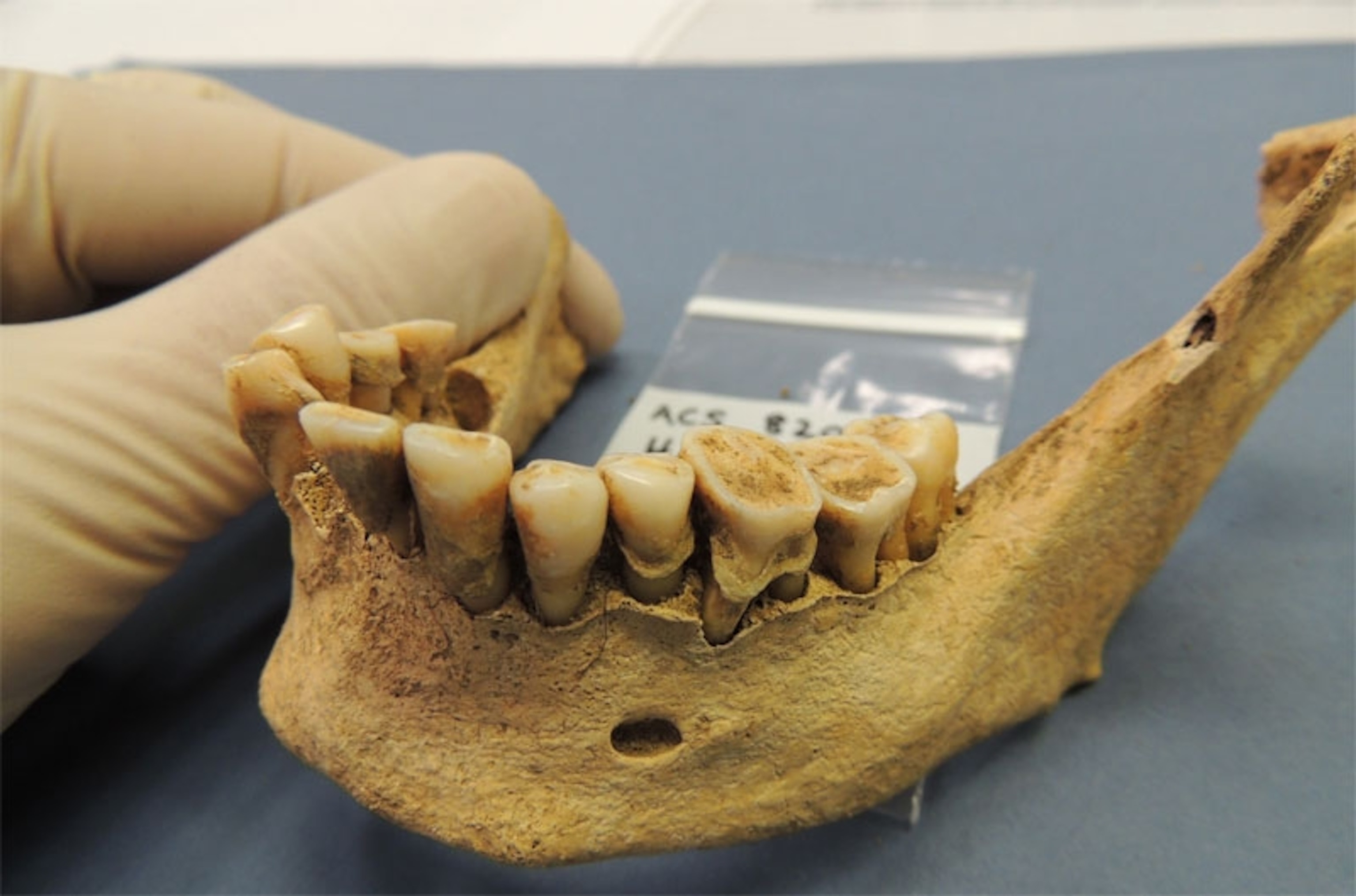
Prehistoric Plaque and the Gentrification of Europe’s Mouth
The man known only as 12011 lived in Poland between 5,450 and 7,500 years ago. He was a hunter-gatherer. He died roughly between the ages of 40 and 45. Beyond that, the details of his life are a mystery. We don’t know what his voice would have sounded like. We don’t know what he liked or disliked. We don’t know why he died.
We do, however, know which bacteria were living on his teeth.
Microbes grew inside his mouth just as they do on yours. They created a layer of plaque on his teeth, which eventually hardened into tartar—a substance that’s structurally similar to concrete. In tartar, bacteria become locked in a mineral cage of calcium phosphate, which is so tough and stable that they can last for thousands of years in pristine condition. That’s why the teeth of many human skulls still contain bacteria that lived inside their owner’s mouths—entombed for millennia, dead but not decayed.
Alan Cooper from the University of Adelaide used these preserved microbes to study how the bacteria within European mouths have changed over 10,000 years of history.
Dental bacteria aren’t necessarily bad. They’re just some of the trillions of microbes that share our body, and that are as much a part of us as our own flesh and blood. Those in our guts get the most attention and are involved in digesting our food. But microbes abound in other body parts too. Some of those in the mouth are involved in repairing damage to teeth and barring the way to more dangerous germs.
As Europeans moved from hunting and gathering to farming and agriculture, these oral communities changed from healthy, diverse ones into those that we’d typically associate with disease. The advent of processed flour and sugar during the Industrial Revolution made things even worse. “You see the diversity plummet, and the rise to dominance of opportunistic nasties such as Streptococcus mutans, which causes cavities,” says Cooper.
Our mouths are now a gentrified shadow of their former selves. And as Carl Zimmer described earlier this week, ecosystems with an impoverished web of species are more vulnerable to parasites. He was writing about frogs and lakes, but the same is true of bacteria and mouths. The narrow range of microbes in industrialised gobs are more vulnerable to invasions by species that cause disease, cavities, and other dental problems. “As an ecosystem, it has lost resilience,” says Cooper. “It basically became a permanent disease state.”

The idea for Cooper’s project germinated 17 years ago after conversations with archaeologist Keith Dobney from the University of Aberdeen. But the tools weren’t ready. Genetic technology was still to primitive and expensive, and the team’s flasks, beakers and lab equipment were contaminated by small traces of modern bacteria. They just didn’t trust their initial experiments.
Since then, the companies that make these consumables have improved and Cooper has built an ultra-clean laboratory at the Australian Centre for Ancient DNA, where he extracts DNA from all manner of extinct animals. He has also worked closely with archaeologists like Dobney, who have collected material using sterile techniques. “That was essential,” he says. “[Tartar] is really common in post-farming specimens but finding material that hasn’t been handled and washed by archaeologists or curators, which introduces contamination, is much more difficult.”
Eventually, the team—led by Cooper’s colleague Christina Adler—ended up with samples from 34 European human skeletons. They ranged from Polish hunter-gatherers who lived up to 7,500 years ago to medieval English people who lived around 1,000 years ago. Ten of the team members also scraped the bacteria from their own teeth for comparison.
The microbes they found were very different from those in the local environment, on laboratory equipment, or within the teeth themselves, which reassured them that they were actually looking at tartar microbes and not contaminants.
The hunter-gatherers had a diverse array of bacteria including several groups that are associated with good health. That fits with the relative absence of tooth decay or gum disease among modern or prehistoric hunter-gatherers. “They were at the end of a long period of happy co-evolution between us and oral bacteria,” says Cooper.
The advent of farming disrupted that tango. After the Agricultural Revolution, as humans began to chow down upon barley, wheat and other domesticated crops, the diversity of the mouth microbes fell, and species associated with oral diseases became more common. “Eating all this soft squishy carbohydrate and leaving it lying around the base of your teeth is effectively inviting in a whole new range of bugs to take up permanent residence in your mouth,” says Cooper.
Nothing much changed for several millennia. Then, during the Industrial Revolution in the 19th century, the advent of refined grains and concentrated sugar winnowed the mouth bacteria down by an even greater degree. Disease-causing species that were virtually absent in prehistoric maws became commonplace, just as they are in modern Europeans. Our changing diet led to changing bacteria and steady employment for centuries of dentists. It’s no coincidence that the same thing has happened to European guts too.
Having narrowed the microscopic worlds in our mouths through millennia of food technology, is there anything we can do about it? The jury’s out. Cooper wonders what would happen if he transplanted the types of bacteria he sees in hunter-gatherers into the mouths of people who eat low-carb diets.
Also: “Avoid mouthwash!” he says. “The modern obsession with removing all bacteria is completely counter-productive. You actually want a diverse microbial community. In this case it’s really important for stopping colonising pathogens, and for filling in tooth damage, and generally maintaining a healthy ecosystem. Our problem is too few bugs, and many of the wrong sort.”
Reference: Adler, Dobney, Weyrich, Kaidonis, Walker, Haak, Bradshaw, Townsend, Soltysiak, Alt, Parkhill & Cooper. 2013. Sequencing ancient calcified dental plaque shows changes in oral microbiota with dietary shifts of the Neolithic and Industrial revolutions. Nature Genetics, citation tbc.
